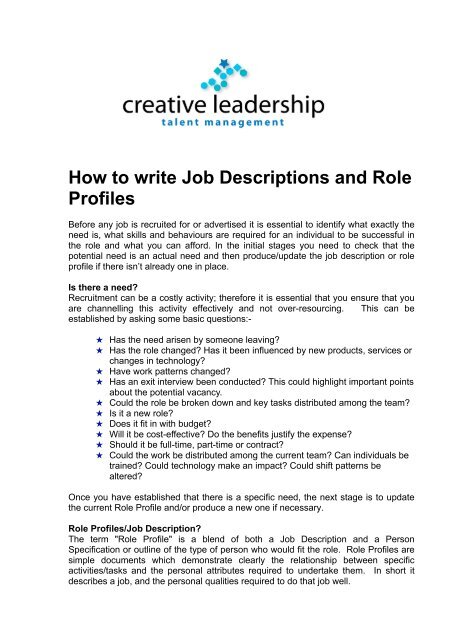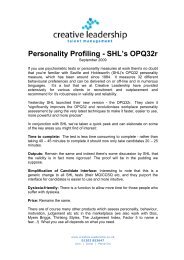How to write Job Descriptions and Role Profiles - Creative Leadership
How to write Job Descriptions and Role Profiles - Creative Leadership
How to write Job Descriptions and Role Profiles - Creative Leadership
Create successful ePaper yourself
Turn your PDF publications into a flip-book with our unique Google optimized e-Paper software.
<strong>How</strong> <strong>to</strong> <strong>write</strong> <strong>Job</strong> <strong>Descriptions</strong> <strong>and</strong> <strong>Role</strong><br />
<strong>Profiles</strong><br />
Before any job is recruited for or advertised it is essential <strong>to</strong> identify what exactly the<br />
need is, what skills <strong>and</strong> behaviours are required for an individual <strong>to</strong> be successful in<br />
the role <strong>and</strong> what you can afford. In the initial stages you need <strong>to</strong> check that the<br />
potential need is an actual need <strong>and</strong> then produce/update the job description or role<br />
profile if there isn’t already one in place.<br />
Is there a need?<br />
Recruitment can be a costly activity; therefore it is essential that you ensure that you<br />
are channelling this activity effectively <strong>and</strong> not over-resourcing. This can be<br />
established by asking some basic questions:-<br />
★ Has the need arisen by someone leaving?<br />
★ Has the role changed? Has it been influenced by new products, services or<br />
changes in technology?<br />
★ Have work patterns changed?<br />
★ Has an exit interview been conducted? This could highlight important points<br />
about the potential vacancy.<br />
★ Could the role be broken down <strong>and</strong> key tasks distributed among the team?<br />
★ Is it a new role?<br />
★ Does it fit in with budget?<br />
★ Will it be cost-effective? Do the benefits justify the expense?<br />
★ Should it be full-time, part-time or contract?<br />
★ Could the work be distributed among the current team? Can individuals be<br />
trained? Could technology make an impact? Could shift patterns be<br />
altered?<br />
Once you have established that there is a specific need, the next stage is <strong>to</strong> update<br />
the current <strong>Role</strong> Profile <strong>and</strong>/or produce a new one if necessary.<br />
<strong>Role</strong> <strong>Profiles</strong>/<strong>Job</strong> Description?<br />
The term "<strong>Role</strong> Profile" is a blend of both a <strong>Job</strong> Description <strong>and</strong> a Person<br />
Specification or outline of the type of person who would fit the role. <strong>Role</strong> <strong>Profiles</strong> are<br />
simple documents which demonstrate clearly the relationship between specific<br />
activities/tasks <strong>and</strong> the personal attributes required <strong>to</strong> undertake them. In short it<br />
describes a job, <strong>and</strong> the personal qualities required <strong>to</strong> do that job well.
The job is usually described in terms of the purpose, responsibilities <strong>and</strong> key<br />
deliverables of the job, <strong>and</strong> the personal qualities required are described in terms of<br />
the knowledge, skills <strong>and</strong> behaviours that are necessary <strong>to</strong> perform the job well.<br />
<strong>Role</strong> <strong>Profiles</strong> provide clarity (both <strong>to</strong> those doing the job <strong>and</strong> <strong>to</strong> managers) on what is<br />
expected from people doing the role. They focus people's attention on the key fac<strong>to</strong>rs<br />
required <strong>to</strong> deliver results. They provide information that enables:<br />
★ A much clearer underst<strong>and</strong>ing of what the role holder is being asked <strong>to</strong> do.<br />
★ More effective appraisal, against a clear benchmark.<br />
★ More effective recruitment, against clearly specified requirements linked <strong>to</strong><br />
business objectives.<br />
★ More effective development of people, focussing learning on the areas that<br />
will bring most business benefit.<br />
★ More effective promotion <strong>and</strong> career development, where people can see<br />
what they need <strong>to</strong> do <strong>to</strong> fulfil a future role, <strong>and</strong> in turn the organisation can<br />
assess people's capability more accurately.<br />
Key benefits businesses gain from using <strong>Role</strong> <strong>Profiles</strong> as opposed <strong>to</strong> <strong>Job</strong><br />
<strong>Descriptions</strong> include:<br />
★ Increased effectiveness from jobholders who are more focussed on what<br />
success looks like in their role.<br />
★ Reduced recruitment <strong>and</strong> retention costs, with people better matched <strong>to</strong><br />
role requirements.<br />
★ Reduced training <strong>and</strong> developments costs, with learning targeted on<br />
activities with defined business benefit.<br />
★ More successful promotion decisions.<br />
★ Fairer, simpler <strong>and</strong> more transparent grading structures.<br />
Producing a <strong>Role</strong> Profile<br />
If you need <strong>to</strong> produce a new <strong>Role</strong> Profile, it should be clear, concise <strong>and</strong> include the<br />
following:<br />
<strong>Job</strong> Description<br />
<strong>Job</strong> title<br />
Reporting line<br />
<strong>Job</strong> purpose<br />
Key accountabilities<br />
A named role <strong>and</strong> location. The job title should<br />
communicate the function <strong>and</strong> status of the job.<br />
The person <strong>to</strong> whom the individual will be<br />
reporting. It is important that this is clarified<br />
particularly where there may be more than one<br />
reporting line for different issues.<br />
A simple statement <strong>to</strong> identify clearly the<br />
objective of the job.<br />
This details what actually needs <strong>to</strong> be done. The<br />
duties <strong>and</strong> expected outcomes.<br />
Knowledge/experience/skills This section is used <strong>to</strong> identify the overall<br />
expertise needed <strong>to</strong> perform the job <strong>to</strong> the<br />
required st<strong>and</strong>ards for example:<br />
Knowledge of specific procedures (e.g. computer<br />
systems <strong>and</strong> software for an IT programmer)<br />
Experience in working with Microsoft packages<br />
www.creative-leadership.co.uk<br />
01202 853647<br />
Join | Grow | Move On<br />
Page 2
The skills <strong>to</strong> apply computer knowledge, skills <strong>to</strong><br />
work as part of a team<br />
Person Specification<br />
Qualifications Academic/vocational/professional. Outline the<br />
minimum requirement for the jobholder <strong>and</strong> what<br />
is ideal.<br />
Work Experience The amount of experience in a specific<br />
environment at a specific level<br />
Knowledge<br />
Specific background/essential knowledge needed<br />
<strong>to</strong> do the job i.e. working practices<br />
Skills/Abilities<br />
Skills <strong>and</strong> abilities required that are specific <strong>to</strong> the<br />
role i.e. numerical/verbal/communication It is<br />
recommended <strong>to</strong> identify a minimum level of skill<br />
<strong>and</strong> also a maximum level of skill <strong>to</strong> indicate<br />
development<br />
Personality/Motivation What motivates the c<strong>and</strong>idate is the role likely <strong>to</strong><br />
restrict someone who enjoys working with people<br />
if it is one which has limited contact with others.<br />
Circumstances<br />
Availability/mobility i.e. is the c<strong>and</strong>idate able <strong>to</strong><br />
work the hours required, or can they travel <strong>to</strong> the<br />
work location.<br />
Competencies/Behaviours A description of which core competencies are<br />
required for the job<br />
It is also useful <strong>to</strong> identify:<br />
★ The essential criteria (skills, experience, attributes) which must be available<br />
<strong>to</strong> undertake the job<br />
★ The desirable criteria (other abilities, attributes, further experience), that<br />
would enhance the quality of the c<strong>and</strong>idates.<br />
This should outline your 'ideal' c<strong>and</strong>idate for the vacancy. C<strong>and</strong>idates who don't have<br />
the essential criteria should be rejected at application stage. While the desirable<br />
criteria are not essential, they may enhance the quality of the c<strong>and</strong>idate <strong>and</strong> this may<br />
be useful if you have a number of good c<strong>and</strong>idates.<br />
You should ensure that c<strong>and</strong>idates meet the benchmark in the competency based<br />
assessment when you shortlist, <strong>and</strong> that you can evidence objective recruitment<br />
decisions have been made.<br />
Attached is a suggested template <strong>to</strong> help facilitate your new role profile.<br />
www.creative-leadership.co.uk<br />
01202 853647<br />
Join | Grow | Move On<br />
Page 3
<strong>Role</strong> Profile Template<br />
<strong>Job</strong> Title:<br />
Reports To:<br />
XXXXXXX<br />
<strong>Job</strong> Title of Line Manager<br />
1. <strong>Job</strong> Purpose<br />
A brief 1 <strong>to</strong> 2 sentence summary of the primary reason why this job exists.<br />
2. Principal Accountabilities<br />
Aim <strong>to</strong> describe around 10 Principal Accountabilities, although some jobs may have<br />
less <strong>and</strong> others more, but avoid listing every single activity. The description should be<br />
generic for any broad role which covers a number of jobholders e.g. Manager,<br />
Adviser etc<br />
Detail the most important aspects of the role spelling out:<br />
★ Responsibilities – what does the jobholder do?<br />
★ Accountabilities –what decisions does the jobholder make?<br />
Start with an active verb, e.g.<br />
★ Manages a team of 4 people <strong>to</strong> ensure....<br />
★ Develops new methods of....<br />
★ Coaches people <strong>to</strong> ensure that they have the capability <strong>to</strong>...<br />
★ Responds <strong>to</strong> telephone calls in a professional manner <strong>and</strong> ensures that .....<br />
It may also be useful <strong>to</strong> have a general accountability, which lends scope for new<br />
tasks e.g.<br />
★ Executes additional tasks in order <strong>to</strong> meet departmental project-related or<br />
development <strong>and</strong> change objectives.<br />
3. Knowledge/Experience/Skills<br />
Consider the qualifications / specific knowledge / type of experience / skills/ type of<br />
behaviours <strong>and</strong> attributes a person may be required <strong>to</strong> possess in order <strong>to</strong> carry out<br />
the job.<br />
a) Knowledge<br />
★ Academic level of qualification required – is an academic level essential?<br />
★ Professional level of qualification required – is there a relevant<br />
qualification?<br />
★ is it essential or desirable?<br />
★ What specific knowledge is required? E.g. knowledge of European family<br />
law<br />
b) Experience<br />
This should include an element of time spent <strong>to</strong> gain the experience – therefore<br />
consider:<br />
★ experience in specific<br />
environments<br />
★ of specific <strong>to</strong>ols<br />
www.creative-leadership.co.uk<br />
01202 853647<br />
Join | Grow | Move On<br />
★ of specific techniques<br />
★ of specific practices<br />
★ of specific exposures<br />
Page 4
e.g. From a Retail background with 3 years’ cus<strong>to</strong>mer service experience including<br />
one year at team manager or supervisory level<br />
c) Skills<br />
Consider the skills or abilities that are required <strong>to</strong> do the job e.g.<br />
★ Working knowledge of Excel<br />
★ Has attention <strong>to</strong> detail<br />
★ High level of numeracy<br />
★ Can “think on feet”<br />
★ Communication skills<br />
★ Can assimilate data<br />
including written <strong>and</strong><br />
presentational<br />
d) Attributes <strong>and</strong> Behaviours<br />
Consider the behaviours / attributes or competencies required <strong>to</strong> carry out the role<br />
e.g. in Team Work:<br />
★ Develops <strong>and</strong> maintains positive working relationships with others<br />
★ Shares ideas <strong>and</strong> information<br />
★ Assists colleagues unprompted<br />
★ Takes pride in the achievement of team objectives<br />
Other elements may include eg<br />
★ Has credibility with peers <strong>and</strong> senior managers<br />
★ Self motivated – driven <strong>to</strong> achieve results<br />
★ High cus<strong>to</strong>mer service ethic – is passionate about meeting cus<strong>to</strong>mer<br />
★ expectations <strong>and</strong> improving service levels.<br />
★ Keeps pace with change – acquires knowledge/skills as the business<br />
develops<br />
4. Context<br />
Explain the context of the role if it is<br />
★ a new role<br />
★ a change <strong>to</strong> the role<br />
Put in<strong>to</strong> context how this role fits in<strong>to</strong> the department/company<br />
Detail the complexity of the role, commenting on impact of role <strong>and</strong> highlighting any<br />
statistical supporting data, e.g.: budgets, numbers of staff, numbers of sites



